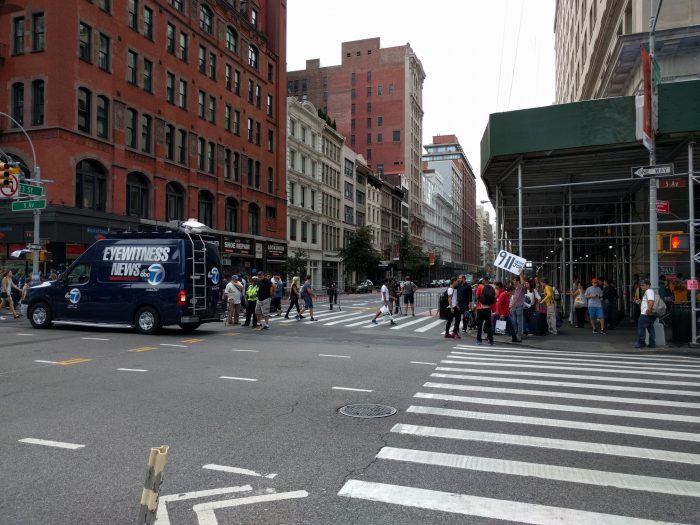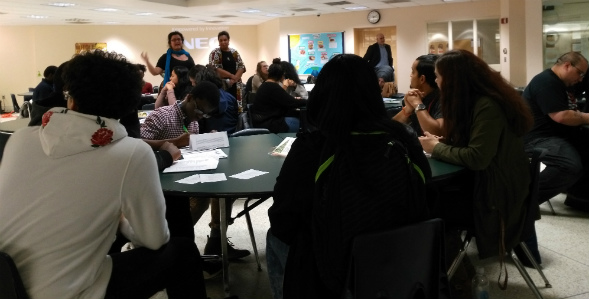As I write this, the block where I used to work in Chelsea, New York City, is still an active crime scene, as investigators try to determine who is responsible for yesterday’s terrorist attack on Manhattan. What is most remarkable, however, is how unremarkable much of the public seems to find what happened.
For the record, I am calling yesterday’s attempt at carnage by a thankfully incompetent plotter a terrorist attack, even though Mayor DeBlasio and Hillary Clinton have not done so yet. While they are trying to be prudent, I have to agree with Gov. Andrew Cuomo, who noted that when someone detonates a bomb in New York City, there really is not much else one can label the action. What’s the reason for caution in calling what happened the proper and most descriptive name? If the perpetrators turn out not to be connected to ISIS or some other overseas Islamist entity, the bomber(s) is still a terrorist. It seems that some liberal Democrats have internalized the notion that terror is an Islamic thing, and, in their zeal not to appear Islamophobic, have shown internalized anti-Islam. They should work on that. Indeed, if the perpetrators were anarchists, it was terror. If they were black nationalists, it was terror. If they were 70s-style Maoists, it was terror. If they were supporters of Trump, it was terror. Maybe it was left-wing terror; maybe it was right-wing terror; maybe it was anti-gay terror. Maybe it was Islamist terror.
And the terrorists’ intent wasn’t confined only to 23rd Street, as we now know. A similar device that thankfully failed to detonate was found on 27th Street. The investigators have announced that the devices in Chelsea, as well as the bomb that exploded on the Jersey Shore yesterday, were made using old-fashioned flip phones, suggesting that all the bombs were made by the same group or person.
But let’s look at the whole of yesterday in context. The evening before, six people were shot in Philadelphia by a mad gunman, one of whom, a 25-year-old woman, died of her wounds. Then the bomb went off in New Jersey near a parade, then the Manhattan bombing happened. At just about the same time at a mall in Saint Cloud, Minn., a man dressed as a guard rambling about Allah went on a stabbing rampage, injuring at least eight people. (ISIS has claimed responsibility for that.)
An armed rampage, two bombings, and a stabbing spree. Philadelphia, Minnesota, and New York.
These horrific happenings mix the sorts of things that Americans used to actually notice together: lone gunmen, terrorists, deranged individuals. But already everything is returning to normal; Facebook feeds are back to talk of football games and whether Hillary’s brief coughing fit means she has tuberculosis.
More and more, it seems that there is a new normal, and it sprang upon us so quickly that no one noticed. Even five years ago, people would have been horrified for weeks by a bomb in NYC (anyone remember when some chemicals caused an explosion in Manhattan about ten years ago, creating ’round the clock media coverage in for days? Or when the lights going off in much of the country due to poor planning by the utility providers stoked fear that al-Qaeda-induced Armageddon was upon America?) This author has always been quick to point out that Americans are sometimes too fearful, and in many ways, we still are. But the new normal, in which people take little note of terror and violent rampages, does not at all bode well. It’s as if we are in a society that’s become numb. Is it worse for Americans to live in fear of the ongoing horrors that started with, perhaps, Columbine? Or is it worse that these things have become so common that people scarcely even take note?
Perhaps people’s seeming apathy is a defense mechanism. After all, the vast majority of the country wanted some slight gun control measures. The president, the most powerful man in the world, pushed hard for these measures after Newtown’s violence. Perhaps when America mourned scores of dead schoolchildren and said, along with their president, “Never again!” only to find out that Congress’s reply was a tacit signal that “again” was far more acceptable than a few meager gun control measures, people decided to turn off their feelings. Or, perhaps, it was the fact that such an evil action, that surely has a complex tapestry of causes – access to guns; poor mental health care nationally; the failure of anyone to notice in advance that the madman was, in fact, mad; such poor security in the school itself despite multiple instances of school shootings; or that a general spiritual malaise in the national psyche, especially pronounced in the youth – was reduced to bickering about gun control and sloganeering.
Maybe, after Orlando, as it has become apparent that the supposedly vast security state the U.S. had built up was not enough to keep a club of young people dancing and enjoying life safe from a local terrorist, people decided it was best to check their feelings.
Add to this new normal the routinization of the type of hateful rhetoric spewed by the Trump campaign and his followers on the right, along with the growing anti-Americanism on the left, and the picture of America that emerges is of a nation on the verge of disintegration, or something far worse.
It might feel good to keep ourselves emotionally unconnected to what’s going on around us. It felt good through much of our history, until we found out – in 2001 – that America is not some isolated land safe from the horrors of the rest of the world. Perhaps it feels good now to believe that the violence we see on TV is so rare that we won’t be affected.
Trouble is brewing across the country. We should meet it face to face before it engulfs everything.



